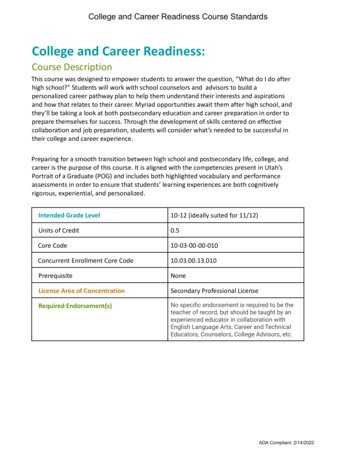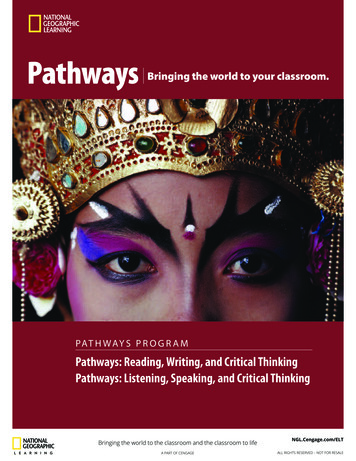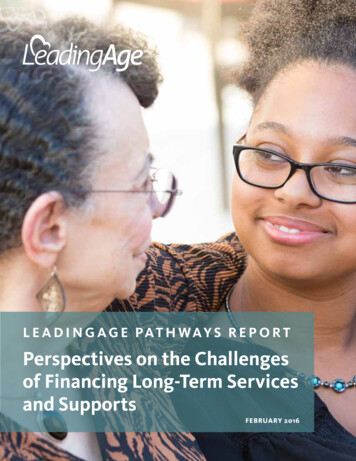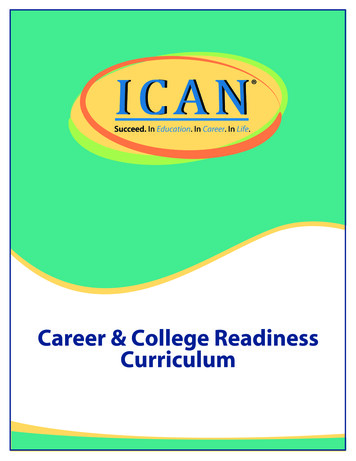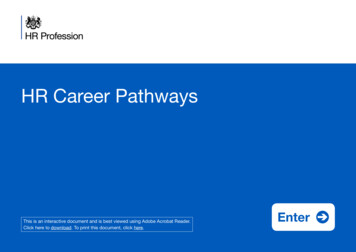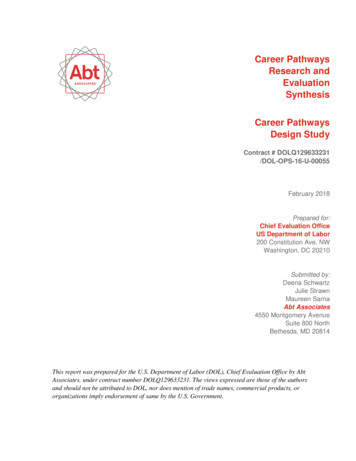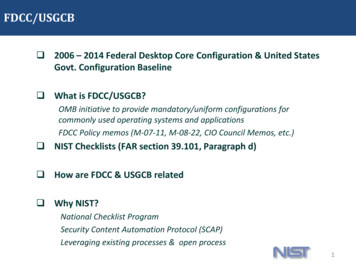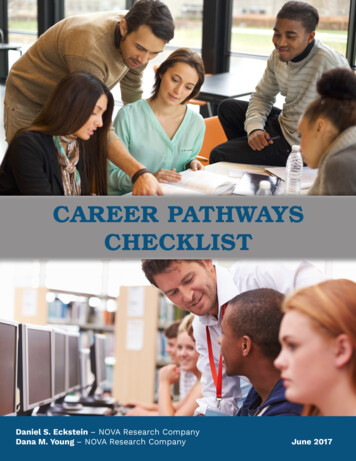
Transcription
CAREER PATHWAYSCHECKLISTDaniel S. Eckstein – NOVA Research CompanyDana M. Young – NOVA Research CompanyJune 2017
AcknowledgementsThis checklist was developed with input from Hope Cotner of the Center for Occupational Researchand Development.The Career Pathways Checklist was funded by the U.S. Department of Education, Office of Career,Technical, and Adult Education under contract ED-VAE-14-O-5014. The opinions expressed hereindo not necessarily represent the positions or policies of the U.S. Department of Education, and noofficial endorsement by the U.S. Department of Education should be inferred. This document is inthe public domain and may be used without permission. June 2017.
IntroductionThe Workforce Innovation and Opportunity Act (WIOA) was enacted on July 22, 2014. WIOA calls forcross-system alignment; education and training that is focused on the needs of high-demand industrysectors and occupations; regional collaboration focused on the skill needs of regional economies; andthe establishment of career pathways systems that make it easier for all Americans to attain the skillsand credentials needed for family-supporting jobs and careers.Within these systems, career pathways programs offer a clear sequence, or pathway, of educationcoursework and/or training credentials aligned with employer-validated work readiness standardsand competencies.What is this checklist for? This checklist is designed as a work aid to help determine the extent to which a newlydeveloped or existing program meets the requirements for career pathways in section(3)(7) of WIOA.Who is this checklist for? Planners and managers of career pathways programsFinancial aid counselors and administrators responsible for administering the Ability toBenefit (AtB) provisions of the Higher Education Act (HEA), that allow a student who doesnot have a high school diploma (or its recognized equivalent) to be eligible for Title IV, HEAstudent assistance through one of the AtB alternatives if the student is enrolled in an“eligible career pathway program” that aligns to the statutory requirements in WIOA.How should the checklist be used? Review each element (letters A–G) of the WIOA career pathway definition to ensure aprogram meets the required criteria.If the program meets a criterion, check the “Yes” box and describe the evidencedemonstrating how the criterion is met.If the program does not meet a criterion, check the “No” box and describe whatenhancements the program needs to make in order to meet the criterion.This program meets this criterion:YesNo How I know it meets this criterion What program changes are needed to meet this criterion
CHECKLISTWIOA Definition of Career Pathway:(7) CAREER PATHWAY—The term ‘‘career pathway’’ means a combination of rigorous and highquality education, training, and other services that—(A) aligns with the skill needs of industries in the economy of the State or regional economyinvolved;Discussion: Career pathways are intended to encourage and expand the number ofstudents, jobseekers, and workers who earn industry-recognized, postsecondarycredentials that correspond to the skill needs of employers in high-demandindustry sectors. Therefore, career pathways programs should engage employersand other stakeholders in: Identifying the skills that are needed by high-demand employersDetermining how students are deemed proficient in these skillsIdentifying the credentials that employers value in making labor marketdecisionsProviding work-based learning opportunities for studentsAdvising how to validate curricula and credentials.This program meets this criterion:How I know it meets this criterion Yes What program changes are needed to meet this criterion No
(B) prepares an individual to be successful in any of a full range of secondary or postsecondaryeducation options, including apprenticeships registered under the Act of August 16, 1937(commonly known as the ‘‘National Apprenticeship Act’’; 50 Stat. 664, chapter 663; 29 U.S.C. 50et seq.) (referred to individually in this Act as an ‘‘apprenticeship,’’ except in section 171);Discussion: Long-term economic trends point to increasing demand for bettereducated workers. Career pathway programs include a full range of secondary,adult education, and postsecondary education options, including RegisteredApprenticeships.*Preparing individuals with diverse backgrounds for success requires variedprograms that offer a range of education and training strategies, careerdevelopment support, and wraparound services, including: Registered ApprenticeshipsContextualized instructionIntegrated education and trainingCareer ladders/lattices/roadmaps to careersCurriculum built on industry competency modelsMultiple entry/exit pointsStackable credentials that lead to certificate/degree attainmentCareer navigation and supportive services.*A Registered Apprenticeship is a formalized and highly structured system oflearning that is a combination of on-the-job training and related classroominstruction in which workers learn the practical and theoretical aspects of a highlyskilled occupation.This program meets this criterion:How I know it meets this criterion Yes What program changes are needed to meet this criterion No
(C) includes counseling to support an individual in achieving the individual’s education andcareer goals;Discussion: Counseling and supportive services are a key component of careerpathway programs. It is important for each individual to have an individualizedacademic and career development plan that shows the unique steps she or he willtake to reach her or his ultimate goal. Counseling should support an individual’sjourney through the pathway and provide “roadmaps” outlining the education andtraining that must be completed and credentials that must be earned to reachidentified career goals.Counseling may include: Career assessmentAcademic and career counseling, planning, and navigationAcademic support, including tutoringSocial support, including referrals to resources and servicesTransition planning to employment or postsecondary education.Supportive services are an important tool in addressing life issues that may occurduring an individual’s participation in a career pathways program. Counselingmay include ongoing assessment of an individual’s need for assistance in a varietyof areas such as childcare, transportation, and financial aid. These much-neededservices allow individuals to participate more fully and help remove barriers toprogram completion.This program meets this criterion:How I know it meets this criterion Yes What program changes are needed to meet this criterion No
(D) includes, as appropriate, education offered concurrently with and in the same context asworkforce preparation activities and training for a specific occupation or occupational cluster;Discussion: Work-based learning experiences, such as internships, job shadowing,and project-based learning opportunities, can help students apply theirknowledge, gain valuable hands-on experience, and develop the day-one readinessand foundational skills necessary to succeed in the labor market.A career pathway program strives, as appropriate, to provide adult educationactivities concurrently with and in the same context as workforce preparationactivities and training for a specific occupation or occupational cluster for thepurpose of educational and career advancement. This could take many formsincluding, but not limited to: basic adult education with contextualized materials;adult education (with or without contextualized materials) and workforcepreparation activities; bridge programs designed for particular occupations oroccupational sectors; integrated education and training (IET); and workplaceadult education and literacy.Articulated career pathways may include short-, moderate-, and longer-termeducation and training programs offered at times convenient for working learnersand those with family responsibilities, and align credential attainment to indemand employment opportunities.In addition, paid work-based learning and apprenticeship programs allowstudents to develop relevant skills while earning money to cover living expenses.Without access to these opportunities, many students will seek paid employmentunrelated to their pathways and likely slow their program completion and careeradvancement. Offering training programs relevant to students’ career interestsalso can improve outcomes such as course completion and/or certification.Contextualizing math and English, English language instruction, and generaleducation will engage and retain students.This program meets this criterion:How I know it meets this criterion Yes What program changes are needed to meet this criterion No
(E) organizes education, training, and other services to meet the particular needs of anindividual in a manner that accelerates the educational and career advancement of theindividual to the extent practicable;Discussion: A variety of individuals participate in career pathways education andtraining programs; a typical semester-based college and university schedule maynot meet the urgency of many career pathways participants to obtain a credentialand find a job. Strategies that allow learners to simultaneously pursue multiplesteps along a pathway can accelerate their progress while maintaining the qualityand integrity of required learning. These may include: Flexible program designWorkplace learningCredit for prior learningDual enrollment.Flexible and accessible education, training, and support services help promoteadvancement. Flexibility in program offerings means more than convenient classschedules. It also includes e-learning that allows students to progress at their ownspeed based on their abilities and schedule; work-based learning; andcompetency-based learning that is skills-based, self-paced, and personalized.Workplace-learning experiences such as job shadows, internships, andapprenticeships help expand and accelerate career pathway opportunities whencombined with classroom instruction.Prior learning assessment strategies honor the content mastery students haveacquired through previous coursework and work experience and can reduce thecost and time required to achieve outcomes within a pathway.Dual enrollment has proven successful in improving the probability that studentswill graduate from high school, transition to college, be less likely to requireremediation, and persist in postsecondary education.This program meets this criterion:How I know it meets this criterion Yes What program changes are needed to meet this criterion No
(F) enables an individual to attain a secondary school diploma or its recognized equivalent, andat least 1 recognized postsecondary credential; andDiscussion: It is projected that by 2020 there will 140–165 million jobs in theUnited States, 65 percent of which will require a high school equivalency plusadditional training or education. Therefore, a career pathways program needs toenable those without a high school diploma or its equivalent to attain one and beprepared to access additional training and education opportunities that lead toadditional credentials. Credentials, both academic and work-related, areimportant milestones for career pathways. Students can earn credentials (at bothsecondary and postsecondary levels) that verify educational attainment andmastery of skills and provide the authority to perform a task or operation. Foremployers, credentials allow them to readily determine the skill or education levelof a job applicant. Credentials can be awarded by various parties and havediffering requirements. The table below provides features and examples of themost common types of warded by EducationinstitutionBusiness, tradeassociation, s from Course of studyAssessmentCourse ofstudyMeetingrequirementsIndicates EducationSkill masteryEducationLegal permissionCompleted in 2 YearsVariable2 YearsVariableExamplesServSafe FoodHandler, GreenManufacturingSpecialist,Certificate inBusinessAdministrationCertified Welder(CW), CertifiedLogistics Technician(CLT), CertifiedInternationalInformation SystemsSecurity Professional(CISSP)Bachelor ofScience,Master ofScience,Doctor ofEngineeringRegistered Nurse(RN),Cosmetologist,Master PlumberThis program meets this criterion:How I know it meets this criterion Yes What program changes are needed to meet this criterion No
(G) helps an individual enter or advance within a specific occupation or occupational cluster.Individuals often face obstacles completing education and training programs andmay need to take a break or deviate from their educational and career plans dueto life circumstances. Career pathway programs provide individuals withmultiple entry points to accommodate academic readiness and multiple exitpoints to allow individuals to obtain employment and return to the programwhen they are ready to progress to the next level of credential attainment.Flexible strategies and services permit interruptions without causing anindividual to veer from an education or career path. This results in increasedaccess to family-sustaining careers and career advancement over time.This program meets this criterion:How I know it meets this criterion Yes What program changes are needed to meet this criterion No ReferencesAssociation for Career and Technical Education. What is a credential? Alexandria, VA: ACTE; n.d.Available from: aspx?id 1917Anthony P. Carnevale, Nicole Smith, and Jeff Strohl. Recovery: projections of jobs and educationrequirements through 2020. Washington, DC: Georgetown Public Policy Institute, Center onEducation and the Workforce; 2013 June. Available from: 11/Recovery2020.ES .Web .pdfU.S. Department of Labor, Employment and Training Administration. Career pathways toolkit: anenhanced guide and workbook for system development. Washington, DC: DOLETA; 2016 Oct.Available ncements/2016/10/20/09/37/Career Pathways Toolkit An Enhanced Guide and Workbook
Discussion: Career pathways are intended to encourage and expand the number of students, jobseekers, and workers who earn industry-recognized, postsecondary credentials that correspond to the skill needs of employers in high-demand industry sectors. Therefore, career pathways programs should engage employers and other stakeholders in:
